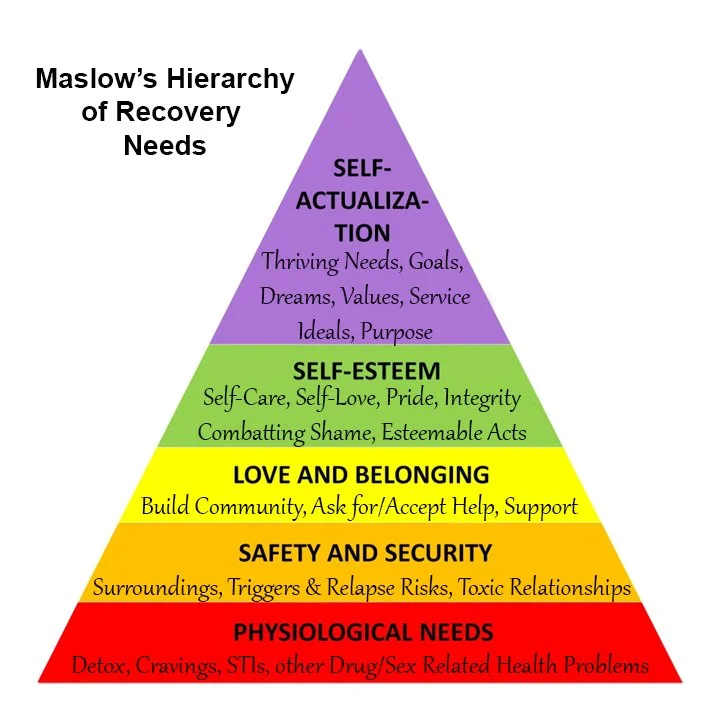Maslow’s Hierarchy of (Recovery) Needs
Maslow's Hierarchy of (Recovery) Needs! At the base of Maslow's pyramid are physiological needs which in this context are things like; detox/withdrawal symptoms, cravings, sex and drug related health issues, and STIs. The next part represents Safety and Security needs, which in this case are things like; safe surroundings, avoiding relapse risks and triggers, and exiting toxic relationships. The next section represents our Love and Belonging needs; building community, being able to ask for and accept help, and having a support system. The next part is our Self-Esteem needs which are things like; self-care, self-love, integrity, pride, combatting shame, and doing esteemable acts. Maslow's final section represents our Self-Actualization needs. These are things like; thriving needs, goals, dreams, values, ideals, being of service, and having purpose.
When you're thinking about using Maslow's Hierarchy of Needs, you start at the bottom and work your way up. If our lower level needs aren't met, we won't be able to focus or make progress on meeting a higher level of needs. For example: if we're in active detox, we won't be able to focus on making our surroundings safe. If our surroundings aren't safe, we won't be able to work on building a support system. Without any support, we won't be able to make progress on building self esteem through esteemable acts. If we have no self-esteem, we won't be able to focus on our thriving needs. Each lower level need we meet, then allows us to make progress on the next level up.
It's also worth noting that the hierarchy isn't stagnant, so we may make a bunch of progress and move our way up, only to find that a new or reoccurring lower level need arises that has to be met before we can continue making good higher level progress.
This hierarchy isn't the only way to envision needs, but it can be very helpful in early recovery to help decide where to put your attention. Without it, we may experience things like having heavy cravings while struggling to work on our ideals. If we focus on managing physiological needs first, we will have an easier time getting those self-actualization needs met later on.
Even with a tool like this, sometimes it can be hard to cut through all the physical, mental, and emotional static and see clearly what your unmet needs are. If we can't separate one need from another how can we use Maslow's Hierarchy? Try starting with physiological needs and looking for pain, discomfort and dysregulation. If your physiological needs are stabilized, look for life stress, insecurity and general instability. If your Safety & Security needs are being met, look for loneliness and isolation. If your Love & Belonging needs are satisfied, look for negative self-talk and feeling the need to keep secrets or edit yourself. If your self-esteem needs are met look for feeling lost, purposeless, and feeling like your just surviving or going through the motions. If all of your needs are being met, keep actualizing. (And try to add some joy, fun, and pleasure in there.)
If you would like a printable worksheet of the Maslow’s Hierarchy of (Recovery) Needs questions, email RecoverAfterDark@gmail.com with the subject line “Maslow.”
